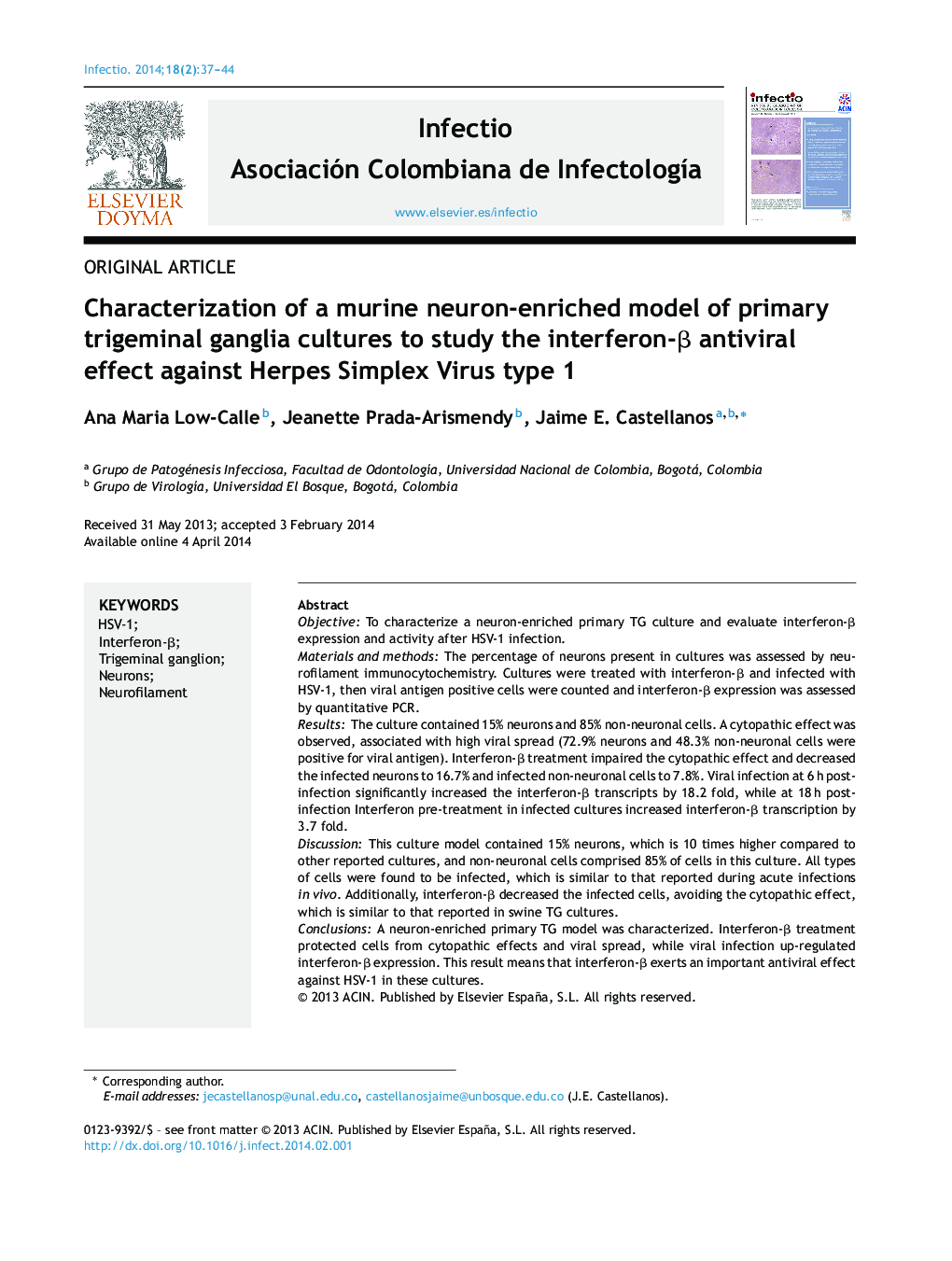| کد مقاله | کد نشریه | سال انتشار | مقاله انگلیسی | نسخه تمام متن |
|---|---|---|---|---|
| 3403672 | 1223082 | 2014 | 8 صفحه PDF | دانلود رایگان |

ObjectiveTo characterize a neuron-enriched primary TG culture and evaluate interferon-β expression and activity after HSV-1 infection.Materials and methodsThe percentage of neurons present in cultures was assessed by neurofilament immunocytochemistry. Cultures were treated with interferon-β and infected with HSV-1, then viral antigen positive cells were counted and interferon-β expression was assessed by quantitative PCR.ResultsThe culture contained 15% neurons and 85% non-neuronal cells. A cytopathic effect was observed, associated with high viral spread (72.9% neurons and 48.3% non-neuronal cells were positive for viral antigen). Interferon-β treatment impaired the cytopathic effect and decreased the infected neurons to 16.7% and infected non-neuronal cells to 7.8%. Viral infection at 6 h post-infection significantly increased the interferon-β transcripts by 18.2 fold, while at 18 h post-infection Interferon pre-treatment in infected cultures increased interferon-β transcription by 3.7 fold.DiscussionThis culture model contained 15% neurons, which is 10 times higher compared to other reported cultures, and non-neuronal cells comprised 85% of cells in this culture. All types of cells were found to be infected, which is similar to that reported during acute infections in vivo. Additionally, interferon-β decreased the infected cells, avoiding the cytopathic effect, which is similar to that reported in swine TG cultures.ConclusionsA neuron-enriched primary TG model was characterized. Interferon-β treatment protected cells from cytopathic effects and viral spread, while viral infection up-regulated interferon-β expression. This result means that interferon-β exerts an important antiviral effect against HSV-1 in these cultures.
ResumenObjetivoCaracterizar un cultivo primario de ganglio trigeminal (GT) enriquecido en neuronas y evaluar la expresión de interferón-β y su actividad frente a la infección con Herpes simple tipo 1 (HSV-1).Materiales y métodosEl porcentaje de neuronas fue determinado por inmunocitoquímica para neurofilamento. Los cultivos fueron tratados con interferón-β e infectados con HSV-1, y se cuantificaron las células positivas para antígeno viral por inmunocitoquímica y la expresión de interferón-β por PCR cuantitativa.ResultadosEl cultivo presentó un 15% de neuronas y 85% de células no neuronales. Se encontró efecto citopático, asociado a una alta diseminación de la infección (72,9% neuronas y 48,3% de células no neuronales positivas para antígeno viral). El interferón-β evitó la aparición de efecto citopático y disminuyó las células infectadas a 16,7% en neuronas y a 7,8% las células no neuronales. La infección viral incrementó la expresión de transcritos de interferón-β 18,2 veces a las 6 h de infección, mientras que a las 18 h post infección el tratamiento con interferón incrementó esta expresión 3,7 veces.DiscusiónLos cultivos presentaron un 15% de neuronas, lo cual es 10 veces más que en otros cultivos reportados. Las células no neuronales representan el 85% de las células del cultivo, y se evidenció que todos los tipos de células se infectaron; similar a lo que ha sido reportado durante infecciones agudas in vivo. Adicionalmente, el interferón-β disminuyó el porcentaje de células infectadas y evitó la aparición de efecto citopático, similar a lo que ha sido reportado en cultivos de GT porcino.ConclusionesSe caracterizó un modelo de cultivo primario de GT enriquecido en neuronas. Interferón-β protegió las células del efecto citopático y la diseminación viral mientras que la infección viral incrementó la expresión de interferón-β. Por lo tanto, el interferón-β ejerció un papel antiviral importante frente al HSV-1 en estos cultivos.
Journal: Infectio - Volume 18, Issue 2, April–June 2014, Pages 37–44